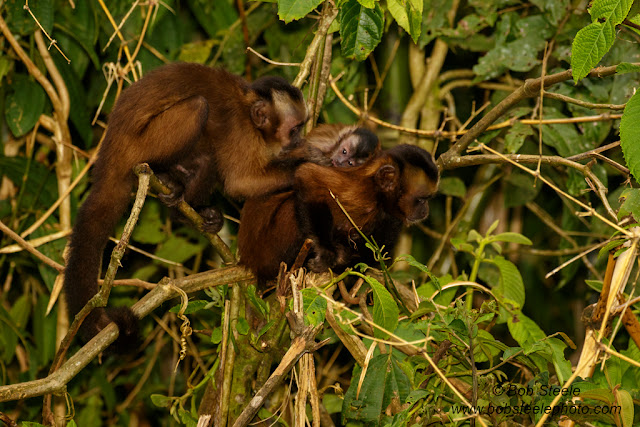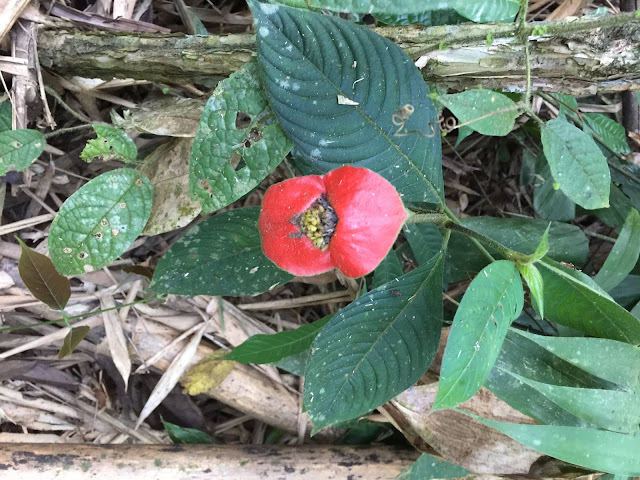 |
| Andean Cock-of-the-Rock |
Our first day out was local to Cusco, birding the Lake Huacarpay and vicinity at the south end of the valley. It was a great introduction to Peruvian birds with mostly open sightings of many new and exciting species. Of special note for all of us was the magnificent Giant Hummingbird, the largest member of its family in the world at 9 inches in length!
eBird checklist for Huarcarpay Lake
 |
| Lake Huacarpay |
 |
| Giant Hummingbird |
 |
| Plumbeous Rail |
 |
| Black-chested Buzzard-Eagle being harrassed by a mountain Caracara |
 |
| Marshland near Lake Huacarpay |
 |
| Some of the habitat near the lake looked more like Sonoran Desert than 12,000 foot elevation Andes |
 |
| Slate-colored Coot |
 |
| Green-tailed Trainbearer |
The next day we left Cusco for good. Cusco sits in a high mountain valley on the west side of the Andean crest. Our route would take us up and over the crest where we would start our descent down the east slope of the Andes all the way to the Amazonian Basin. We stopped just below one pass on our morning drive for a little casual birding at 13,200 feet! huff, puff... But the birds of this high mountain scrub land were unique and it would be our only chance for most of them. Common Miner, Cream-winged Cinclodes, and Taczanowski's Ground-Tyrant, just to name a few, were worth the hard-breathing effort of tromping around the high mountain meadow.
Google map of high mountain meadow
eBird checklist for high mountain meadow
 |
| Birding a high meadow at over 13,000 feet elevation |
 |
| The crest was only 14,000 feet elevation where we crossed. Several mountains in this area are over 17,000 feet |
 |
| Andean Flicker |
 |
| Cream-winged Cinclodes |
 |
| Taczanowski's Ground-Tyrant |
eBird checklist for Abra de Acjanaco
 |
| Entrance to Manu National Park at Abra de Acjanaco |
We birded our way down the slope eventually arriving at the Wayqecha Biological Research Station at an elevation of 9,300 feet. Here we would spend two nights, birding the high cloud forest environment, before continuing down slope. Hummer feeders at the station provided great looks at some new species, and the forests nearby added many new species to our lists. And the Andean Fox we had several great looks at was pretty special.
Google map of Abra de Acjanaco and Wayqecha
sample eBird checklist Wayqecha 1
sample eBird checklist Wayqecha 2
sample eBird checklist Wayqecha 3
 |
| Grass-green Tanager |
 |
| Andean Fox |
 |
| Long-tailed Sylph |
 |
| Masked Flowerpiercer |
The road isn't all that busy, so birding on the road downhill was our typical venture and very pleasant. The slopes are so steep and forested here that there really isn't any other way to bird.
eBird checklist birding down the road
 |
| Clouds crawl up the canyon from Amazonia below |
 |
| Cock of the Rock Lodge |
We stayed at Cock of the Rock Lodge (elevation 4,500 feet) for four nights, watching the extensive feeders at the lodge and birding the road above and below. The birding was spectacular as expected, and a number of mammals made appearances to add to our enjoyment.
sample eBird checklist COTR Lodge 1
sample eBird checklist COTR Lodge 2
sample eBird checklist COTR Lodge 3
sample eBird checklist COTR Lodge 4
 |
| Guide Fernando looks for birds |
 |
| One of the dozens of waterfalls along the road |
 |
| Birding the road |
 |
| Fernando looks down a particularly scary spot in the road |
 |
| Andean Cock-of-the-Rock |


Of course there were many other species to be seen, hundreds in fact. After four days we felt we had hardly scratched the surface.
Google map of Cock of the Rock Lodge
 |
| Blue-banded Toucanet |
 |
| Gray-breasted Mountain-Toucan |
 |
| Cinnamon Flycatcher |
 |
| Blue-gray Tanager |
 |
| Booted Racket-tail |
 |
| Crested Quetzal |
 |
| Golden-headed Quetzal |
 |
| Silver-beaked Tanager |
 |
| Russet-backed Oropendola |
 |
| Sparkling Violetear |
 |
| Speckled Chachalaca |
 |
| Wire-crested Thorntail |
 |
| Wire-crested Thorntail male displays for female |
 |
| Wire-crested Thorntail |
 |
| Large-headed Capuchin monkey |
 |
| Large-headed Capuchin |
 |
| Large-headed Capuchin family group |
 |
| Brown Agouti |
 |
| Tayra, a large member of the weasel family |
Google map of Villa Carmen
eBird checklist birding down to Villa Carmen
sample eBird checklist Villa Carmen 1
sample eBird checklist Villa Carmen 2
 |
| Amazon Hot Lips Flower |
 |
| Fernando shows us how it got its name |
 |
| Bluish-fronted Jacamar |
 |
| Gray-cowled Wood-Rail |
 |
| Hoatzin |
 |
| Orange-backed Troupial |
 |
| Red-capped Cardinal |
 |
| Smooth-billed Ani |












What interesting and gorgeous birds. I'm glad you were able to get such great photos. The mammals are a real treat, too. Some of the birds and terrain remind me of Costa Rica. sigh...
ReplyDeleteI also like seeing the scenery.
ReplyDeleteExcellent photos and blog. It was like I was there again! Thanks for sharing. Frances
ReplyDeleteEmbark on an unforgettable 15-day birding adventure in Northern Peru, where you’ll explore the rich biodiversity of the region. From the elusive Long-whiskered Owlet to the vibrant Marvelous Spatuletail, Northern Peru offers a wealth of birding opportunities. Ideal for bird photographers, this tour takes you through top birding locations, showcasing rare and endemic species. Join us for an exclusive birding experience! Birds Of Northern Peru
ReplyDeleteExperience the best Bird Watching Tours Peru has to offer with expert local guides who lead you through lush cloud forests, Amazon lodges, and Andean hotspots. Discover vibrant endemic species, diverse habitats, and immersive birding adventures designed for nature lovers seeking authentic Peruvian wildlife encounters.
ReplyDelete